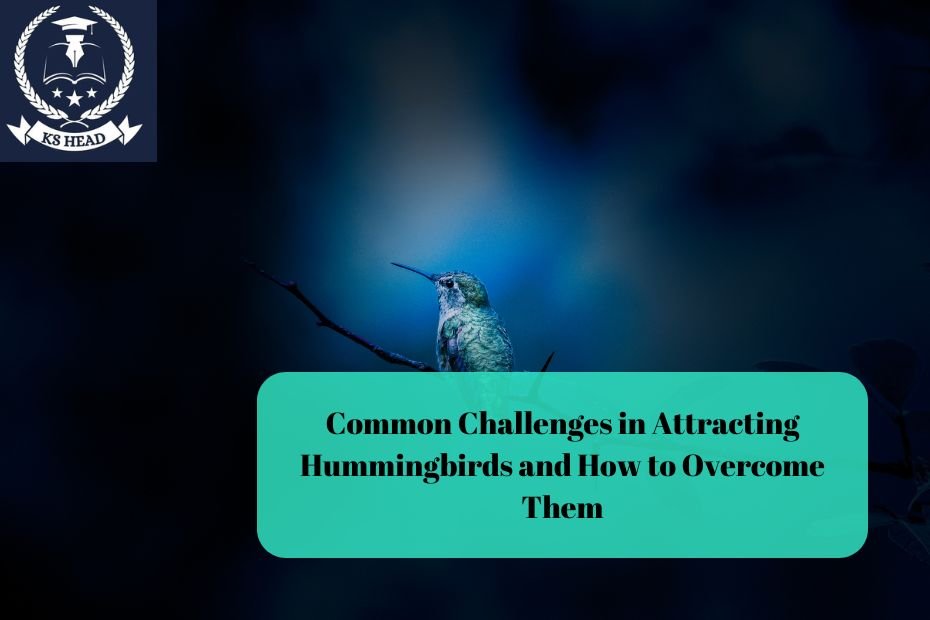Attracting hummingbirds to your garden can be a delightful experience, but it also comes with its challenges. These tiny, vibrant birds are not only beautiful to watch but also play a vital role in pollination. However, creating an environment that appeals to them requires some knowledge and preparation. This article will discuss common challenges faced by gardeners when trying to attract hummingbirds and offer practical solutions to overcome these obstacles.
1. Lack of Food Sources
Challenge:
Hummingbirds primarily feed on nectar from flowers, but not all plants provide the right nutrition. Additionally, they also require small insects and spiders for protein, especially during breeding season.
Solution:
To attract hummingbirds, choose native plants that produce abundant nectar. Some great options include:
- Bee Balm (Monarda spp.): This perennial produces vibrant flowers that hummingbirds love.
- Trumpet Vine (Campsis radicans): This vigorous vine produces large, tubular flowers that attract hummingbirds.
- Salvia (Salvia spp.): Many species of salvia have long blooming periods and are excellent for attracting hummingbirds.
- Fuchsia (Fuchsia spp.): These plants offer beautiful, pendulous flowers that hummingbirds find irresistible.
In addition to nectar, consider providing a source of protein by incorporating plants that attract insects. Avoid pesticides to ensure a healthy environment for both hummingbirds and their food sources.
2. Competition from Other Birds
Challenge:
Hummingbirds can be territorial, and larger birds or aggressive species may drive them away from feeders or preferred feeding areas.
Solution:
To minimize competition, try these strategies:
- Multiple Feeders: Place several feeders around your yard, ideally in different locations, to reduce competition and allow more hummingbirds to access food simultaneously.
- Feeders with Guards: Use feeders with baffles or guards that deter larger birds while allowing hummingbirds to feed comfortably.
- Dispersed Planting: Arrange flowering plants throughout your garden rather than clustering them in one area. This will help ensure that hummingbirds have access to food without interference from other birds.
3. Incorrect Feeder Placement
Challenge:
Feeder placement is crucial for attracting hummingbirds. If feeders are placed in unsuitable locations, birds may not find them or may be deterred from visiting.
Solution:
Consider the following tips for optimal feeder placement:
- Visibility: Place feeders in open areas where hummingbirds can easily spot them. They are attracted to bright colors, so position them near flowering plants or in sunny spots.
- Shelter: Position feeders near natural shelter, such as shrubs or trees, where hummingbirds can perch and feel safe from predators.
- Height: Hang feeders at eye level or slightly above. This makes it easier for hummingbirds to access them and for you to enjoy watching them.
4. Poor Feeder Maintenance
Challenge:
Dirty feeders can deter hummingbirds and even harm them. Mold, sugar buildup, and stale nectar can cause health issues for these birds.
Solution:
Regular maintenance is essential for attracting hummingbirds:
- Clean Feeders: Rinse and clean feeders with hot water and a brush every few days, especially in hot weather. Avoid using soap, as residue can be harmful to hummingbirds.
- Fresh Nectar: Change the nectar solution every few days. A simple mix of four parts water to one part sugar will suffice. Boil the mixture to dissolve the sugar, and allow it to cool before filling the feeder.
- Monitor for Pests: Keep an eye out for pests like ants or wasps. If you notice any, clean the area and consider using ant guards or feeders designed to keep them away.
5. Seasonal Changes
Challenge:
Hummingbird activity can vary significantly with the seasons. Depending on your region, they may only visit during certain times of the year, making it challenging to maintain consistent attraction.
Solution:
To adapt to seasonal changes:
- Plant for All Seasons: Choose a variety of plants that bloom at different times throughout the year. This will provide a continuous food source for hummingbirds, even as seasons change.
- Extend Feeding: Keep feeders out year-round, even after the migration period. Some hummingbirds may linger longer than expected, and you wouldn’t want to miss the chance to attract them.
- Research Migration Patterns: Familiarize yourself with local hummingbird migration patterns to prepare your garden ahead of time. This knowledge can help you anticipate their arrival and ensure they have plenty of food sources when they return.
6. Environmental Factors
Challenge:
Changes in climate and local weather patterns can affect hummingbird populations and their migratory behaviors. Droughts or unusually cold temperatures can lead to food shortages.
Solution:
While you can’t control the weather, you can create a resilient environment:
- Water Sources: Provide fresh water in shallow dishes or bird baths. Hummingbirds often need water for drinking and bathing, especially during hot weather.
- Native Plant Gardens: Native plants are better adapted to local conditions and can provide reliable food sources for hummingbirds even during environmental changes.
- Climate Awareness: Stay informed about local climate patterns and adjust your planting and feeding strategies accordingly to support hummingbirds through challenging conditions.
7. Lack of Knowledge
Challenge:
Many people may not be aware of the specific needs and behaviors of hummingbirds, leading to ineffective attempts at attracting them.
Solution:
Education and community engagement can help:
- Research: Take the time to learn about hummingbird species native to your area and their specific preferences.
- Community Involvement: Join local gardening clubs or hummingbird conservation groups. Engaging with others can provide valuable insights and tips for attracting hummingbirds.
- Share Information: Educate friends and family about hummingbirds and how they can create hummingbird-friendly environments in their gardens.
Conclusion
Attracting hummingbirds can be a rewarding experience, but it requires understanding their needs and overcoming various challenges. By providing ample food sources, maintaining clean feeders, and creating a welcoming environment, you can increase your chances of attracting these beautiful birds to your garden. With a bit of effort and knowledge, you can enjoy the vibrant presence of hummingbirds and contribute to their conservation.
FAQs
- What is the best type of feeder to attract hummingbirds?
The best feeders are those that are easy to clean, have bright colors, and come with ant guards. Look for feeders with multiple feeding ports. - How can I tell if hummingbirds are visiting my feeder?
Look for signs like increased activity around the feeder, hummingbird calls, or sightings of the birds themselves. - What should I do if I see aggressive behavior among hummingbirds at my feeder?
Consider adding more feeders to the area to reduce territorial disputes, and space them out to allow multiple birds to feed simultaneously. - How do I make homemade nectar for hummingbirds?
Mix four parts water to one part granulated sugar, boil to dissolve, and let it cool before filling the feeder. - When is the best time to put out hummingbird feeders?
It’s best to put out feeders a couple of weeks before you expect the hummingbirds to arrive in your area, usually in early spring.

